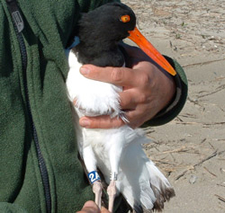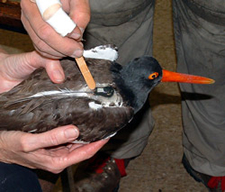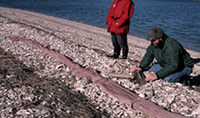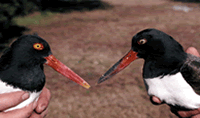American Oystercatchers - Banding and Radio Telemetry


Oystercatcher Banding and Radio Telemetry During the autumn/winter of 2002 - 2004, the South Carolina Department of Natural Resources, Clemson University and the United States Fish and Wildlife Service (USFWS) have captured and banded over 200 American oystercatchers. From reports of these banded birds during the nesting season we have discovered that some birds that winter in South Carolina migrate as far as Massachusetts to breed. Oystercatchers return to the same nesting site each year. Therefore, a capture/resighting model is being used to estimate adult survival of resident banded birds. An accurate estimate of adult survival rate is important in predicting effects of low reproductive success observed in American oystercatchers.


A cannon propelled net is used to capture oystercatchers at high tide when they are aggregated in flocks. Cannons rapidly deploy a net over small flocks of oystercatchers. Captured oystercatchers are measured, weighed, photographed and color-banded for individual identification. A numbered USFWS metal band is placed on the upper left portion of the leg and a unique engraved dark blue band is fitted on the upper right leg.
Additionally, some captured oystercatchers are radio instrumented. Radio transmitters are temporarily glued to the skin between feather tracts on the backs of birds. Instrumented birds are being tracked to document habitats used for feeding. Bird identification, habitat type, bird activity, date and time are recorded for each sighting. Observations of radio-instrumented birds show that oystercatchers in South Carolina primarily eat small oysters, clams and mussels during the winter.
